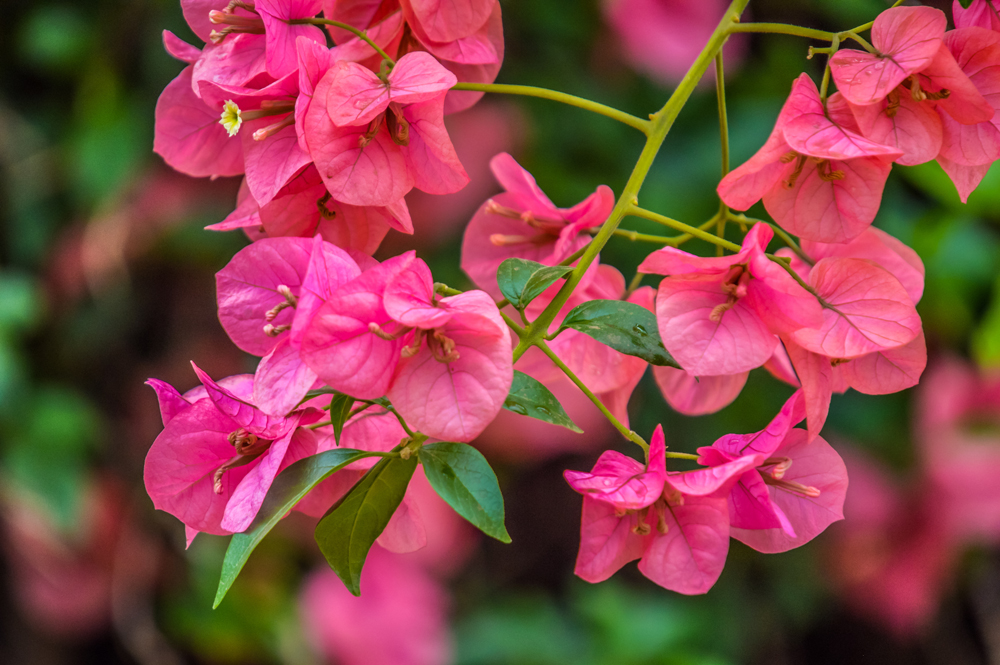Bougainvillea glabra
Common Name
Bougainvillea

General Information:
Bougainvillea, named for a French navigator, is a native of South America and is grown extensively in the warmer climates of the United States. It is a member of the Nyctaginaceae family with close relatives being the four o’clock and the sand verbena. Bougainvillea is an evergreen vine which is just as happy spreading horizontally or hanging downwards as it is climbing upwards, it makes itself at home in almost any situation. It can be grown as a hedge, groomed as a ground cover, pruned as an espalier, trained as a tree or contained in a pot in a variety of shapes. Its trunk tends to be gnarled. Bougainvillea is ideal for bonsai. Red, violet, orange, yellow or white bracts appear on the ends of new growth.
Bougainvillea are available in nurseries and from bonsai specialty growers. A good source is from old gardens being redesigned and from trash piles where a frustrated homeowner has thrown the thorny plant.
They flower most heavily in winter and early spring, but some plants put forth scattered clusters all year. The colours are found in tones of purple, lavender, carmine, scarlet, red, pink, orange, yellow and white. Single and double flower forms are available. Double forms tend to carry their blooms near the end of the stems rather than distributing them evenly over the plant. The colourful, papery “blooms” are not flowers; they are bracts. The true flower is white, trumpet shaped and almost unnoticeable within the bracts. Bougainvilleas are available in a variety of species, each having its unique characteristics.
Lighting:
Full sun.
Temperature:
Being a warm weather plant, they must be provided winter protection. They can usually tolerate die back from a freeze, but will withhold blooms for awhile.
Watering:
Sparse to light watering and good drainage.
Feeding:
Fertilize once in the spring with a low nitrogen fertilizer and maybe once again in the fall. The old established method of forcing flowers is to withhold water to a point of causing severe stress to the plant. Research at the University of Florida has found that plants flower best when given high nitrogen fertilizers and short day lengths (15 hours of darkness within every 24 hour period).
Pruning and wiring:
The bougainvillea takes well to pruning; a useful attribute in styling bonsai. Because bougainvillea generally blooms on new growth, each branch, as blooms begin to fade, should be cut back to a point somewhat shorter than the desired length. Seal all cuts to prevent rot. If rot is detected on a collected specimen, cut it out completely.
Propagation:
Bougainvillea may be grown from air layers, root cuttings and branch cuttings. Young shoots, a few inches in length, should be placed in sandy soil with bottom heat and moisture. Half-ripened or old wood cuttings in six to twelve inch lengths may be rooted April to June.
Repotting:
Repot in Spring. Do not prune the roots too severely.
Pests and Diseases:
Caterpillars, aphids, scale, greenfly and mineral deficiencies (chlorosis). Care must be taken that fungus does not invade the tree; reduced humidity and a preventive spraying of fungicide will help greatly.
Species used for bonsai:
Bougainvillea brazilinensis: ‘Pink Pixie’ bougainvillea.
Bougainvillea buttiana ‘Golden Glow’ - Has bright yellow bracts which fade to apricot.
Bougainvillea buttiana ‘Louis Wathen’ - orange bracts.
Bougainvillea buttiana ‘Mrs. Butt’: - crimson bracts.
Bougainvillea buttiana ‘Orange King’.
Bougainvillea glabra: paper flower, lesser bougainvillea - the most common species used for bonsai. It has shiny green, slightly hairy leaves and magenta colored bracts.
Bougainvillea glabra ‘Magnifica’ - rose pink bracts.
Bougainvillea glabra ‘Snow White’ - white bracts.
Bougainvillea peruviana - rosy pink bracts.
Bougainvillea spectabilis - pink or mauve bracts.
Bibliography:
“Beautiful Bougainvilleas”, Florida Bonsai, XI, 4:37-40. “Bougainvillea”, by Marge Pierce, Florida Bonsai, XVII, 2:18. “Bougainvillea”, by Broward County Agricultural Agents’ Office, Florida. “Notes from Lecture/Demonstration by Maria Elena de Duran”, by Elyse Van Dyke, Florida Bonsai, XXII, 3:2-5.
Interview with Mary Madison, April 27, 1993 by Sena H. Zane.
Florida Bonsai X:1:45
Florida Landscape Plants by Watkins pg.148
Internet Bonsai Club version compiled by Sabrina Caine.
Compiled by Thomas L. Zane
